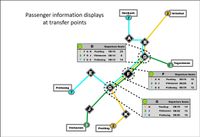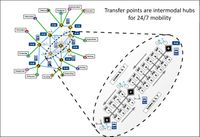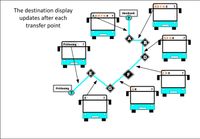A) General questions about the survey
B) Questions about today's public transport
Answer help:
● B1.1 -- Very important
- I am dependent on the public transport network and have no or few alternatives to it.
● B1.2 -- Important
- I rely on the public transport network for my most necessary mobility needs.
● B1.3 -- Mostly unimportant
- I use the public transport network when it is convenient for me (e.g. theater ticket).
● B1.4 -- Neglectable
- I solve my mobility needs myself with my own vehicles such as car, motorcycle, bicycle or use carpooling, car sharing, etc..
Answer help:
● B2.1 -- Very good
- The public transport of my city/region is very well available for my destinations with good intervals between 5 and 15 minutes.
- Apart from that, I also use the existing mobility offer of my city/region via mobility app on my smartphone.
● B2.2 -- Good
- For my regular destinations, I know the data such as lines, transfer points and departure times.
- Apart from that, I also use the existing mobility offer of my city/region via mobility app on my smartphone.
● B2.3 -- Okay
- The frequency is fine for the main lines and during peak hours.
- Alternative mobility offers of my city/region are not available or unattractive because of fare (e.g. cab) and applicability (e.g. e-scooter).
● B2.4 -- Bad
- Public transport often does not offer me suitable transportation for my destinations and appointments.
- Alternative mobility offers of my city/region are not available or unattractive because of fare (e.g. cab) and applicability (e.g. e-scooter).
- I use my own vehicles such as car, motorcycle, bicycle or use carpooling, car sharing, etc..
Answer help:
● B3.1 -- Good
- I have a good overview over the public transport network and have memorized the individual departure times of the lines for my destinations and appointments.
- The public transport service is sufficient for my mobility needs.
● B3.2 -- Okay
- The entire public transportation system is difficult to navigate and remember.
- I only have the public transport lines and departure times for my destinations in my head and otherwise use a mobility app on my smartphone.
● B3.3 -- Bad
- The entire public transportation system is difficult to navigate and remember.
- Changing bus routes at transfer points in the public transport network to reach my destinations more directly and quickly is not guaranteed.
- Switching ride devices and/or ride providers including public transit and rail to reach my destinations cannot be safely coordinated due to different mobility apps.
C) Questions about the OMOD® concept for you as current and future public transport passengers
The essential features of OMOD® are summarized here:
- OMOD® divides the existing public transport lines into sub-routes, the end points of each of which are a transfer point or terminal stop.
- OMOD® thus makes demand-driven, intermodal and networked mobility systems robust and resilient to disruptions and failures.
- One goal of OMOD® is to bundle the transport capacities of public transport vehicles on common sub-routes in order to reduce the traffic load on the roads while maintaining or even improving mobility services for the benefit of the environment and the quality of life.
- In step 2 of the OMOD® implementation, the transport capacities of private mobility providers are also taken into account for this purpose.
- On suitable and prepared sections of the route, OMOD® can also be used to easily integrate autonomously driving vehicles into the public transport network.
- In the final step 3 of the OMOD® implementation, the timetable-related trips can be reduced compared to the demand-oriented transport orders to such an extent that the public transport vehicles only drive the partial routes in the public transport route network for which transport orders exist. The remaining schedule-related trips in the public transport route network will continue to be executed independently of transport orders.
- OMOD® results in a continuous local transportation planning based on current and historical mobility data that is aligned with actual demand.
Concept: | Concept: |
Answer help:
● C1.1 -- Yes
- OMOD® would finally help me assess the travel directions of the individual public transport lines more easily and quickly, and this for all cities/communities that I travel to both privately and for business.
- With OMOD®, I would find my way around the entire public transport network more easily and, in my opinion, more safely, even without a smartphone and mobility app.
- Since OMOD® initially takes over the existing public transport route network with its timetables unchanged and complements it with demand-oriented and intermodal offers, my mobility with public transport can only improve.
● C1.2 – Maybe
- The public transport share of my mobility needs is currently satisfactorily covered.
- When I use public transport for my mobility, I already let the mobility apps of the respective city/municipality on my smartphone guide me during the journey.
- However, I would be happy to get involved with the OMOD® concept if it meant that I could satisfy my mobility needs in a less complicated, less expensive and more flexible way.
● C1.3 -- No
- In general, I would like the public transport route network to remain as it is. Changes to the existing public transport network and its timetables are irritating, unless they complement the existing public transport service.
- Naming the transfer points with short symbols or letters would not be an orientation aid in the public transport line network for me.
Concept: | Concept: |
Answer help:
● C2.1 -- Yes
- This is very helpful for me because I can now immediately see which incoming bus routes can be used for my destination through the vehicle destination display, and that without the help of a mobile app. Previously, I only knew by heart the approximate route of the bus lines I was familiar with. Now I can get on any bus line that stops at my transfer points on the way to my destination.
- If the public transport lines at the transfer points also synchronize their departure times via OMOD®, then I can also reduce the journey times to reach my destinations by optimally transferring to the corresponding connecting lines.
● C2.2 -- Maybe
- The public transport share of my mobility needs is currently satisfactorily covered.
- When I use public transport for my mobility, I already let the mobility apps of the respective city/municipality on my smartphone guide me during the journey.
- However, I would be happy to get involved with the OMOD® concept if it meant that I could satisfy my mobility needs in a less complicated, less expensive and more flexible way.
● C2.3 -- No
- In general, I would like the public transport route network to remain as it is. Changes to the existing public transport network and its timetables are irritating, unless they complement the existing public transport service.
- Naming the transfer points with short symbols or letters and displaying the next transfer points to be approached on the destination display of the public transport vehicles would not be an orientation aid in the public transport route network for me.
D) Questions about the OMOD® concept if you were a planner of tomorrow's public transport system
Answer help:
● D1.1 -- Yes
- It enables us to gradually introduce demand-responsive public transport for the population, as OMOD® allows us to smoothly vary the mobility offer on the sub-routes between purely timetable-based and purely demand-responsive services.
- For partial routes with low demand, we can deploy suitable vehicle sizes in line with demand, thus reducing the traffic load on the roads in a controlled manner.
- For partial routes with high demand, we can bundle the capacities of transport vehicles according to need, thus reducing the traffic load on the roads in a controlled manner.
- With OMOD®, traditional passengers do not feel excluded from the mobility offer if they do not want to or cannot use a mobile app for their mobility.
- As an urban planner, I can design attractive meeting places at the transfer points identified by OMOD®.
● D1.2 -- Likely
- If the majority of society sees the need to change its mobility behavior, OMOD® is an optimal solution to meet society's mobility needs around the clock in an environmentally friendly and cost-effective manner.
- The OMOD® solution would have to be seen as an overarching standard for demand-oriented and intermodal mobility.
● D1.3 -- Unlikely
- Our public transportation system is already sufficiently available around the clock via subway, commuter rail plus connections to supra-regional train services.
- The bus routes we have established tend to meet specific transportation needs identified through our local transportation planning (commuter and school routes, express routes, commercial centers).
- Public transport planning typically has a planning horizon of 3, 5 and 10 years. Therefore, it might be difficult to compare already initiated and planned measures with new concepts like the OMOD® concept.
- Modern mobility concepts such as ride sharing and micro-mobility providers can better develop in parallel with public transport.
● D1.4 -- No
- Convincing the majority of the society of the OMOD® concept of the partial routes and designations of the transfer points will be difficult and risky for the public transport authority. Getting the OMOD® concept rolled out as a standard would be helpful. However, the clarification and enforcement of this would probably take a very long time.
- It is better to start up new mobility concepts in parallel to the usual public transport solution. Implementation is faster and the risk is not carried by the public transport authorities.
Do you have further questions, suggestions, opinions, hints?
Then please write us at
info(at)o-mod.de.
We will get in touch with you promptly.
Parts of the text were translated with help from www.DeepL.com/Translator (free version)



